“My yard is too shady for a vegetable garden” is a common lament among homeowners with mature trees on their property, or tall buildings or other structures that darken the landscape. The statement is only partially true, however. While most vegetables need at least six hours of direct sun to flourish, there are a surprising number of shade-tolerant edibles out there, including vegetables, fruits, herbs and nuts.
The trick is to match the edibles with your specific growing conditions, as there is a wide spectrum of shadiness — a south-facing slope with filtered sunlight through deciduous trees will actually support a range of sun-loving species, while a north-facing slope planted with dense conifers has limited options. Whether you’d like to grow herbs in a container garden on a shaded balcony or patio, or have an extensive forest garden that you’d like to make more productive, there are probably a few edible options out there that will suit your needs.
Too much sun? See how to grow an edible garden on a hot, dry site
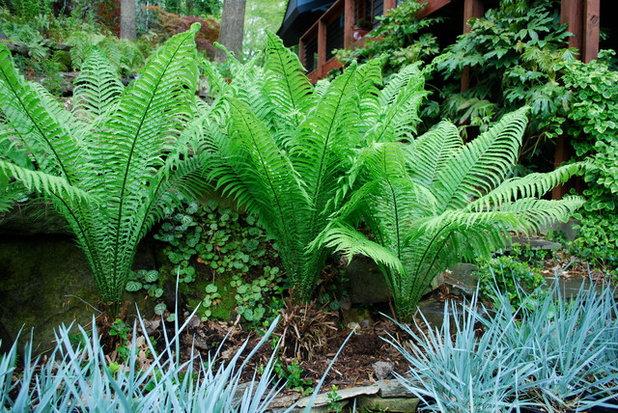
Jay Sifford Garden Design
Shade is not the only challenge in growing food under trees. You must also contend with the root systems of trees, which are always equal to or greater in size than their canopies. Tilling soil filled with tree roots is generally not an option, so if vegetables are to be grown, they’ll need to be in raised beds or planters.
Trees also alter the soil chemistry (soil is usually more acidic in forests, for example), so it’s best to focus on plants that have evolved to thrive in forest conditions. Ferns are a great example. They are rarely grown by gardeners as a food source, but the unfurled fronds, or fiddleheads, are edible on some species. Ostrich fern (
Matteuccia struthiopteris, USDA zones 2 to 8; find your zone), pictured here, is an ornamental fern that is the source of wild fiddleheads in the northern United States — but it is completely at home in a garden setting and thrives in the deepest shade. Ostrich ferns are excellent in cold climates.
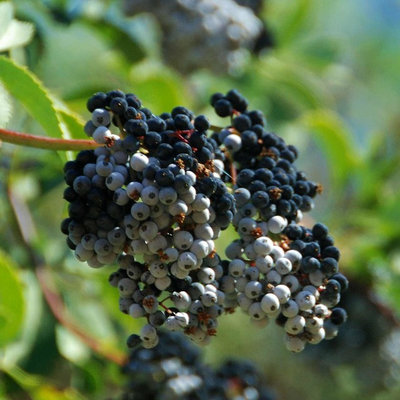
Pete Veilleux, East Bay Wilds
Berries Are a Good BetMost berry-producing species have evolved to grow at the forest edge and will grow quite happily with just a few hours of direct sun each day, or a full day of filtered sun. Some, like blueberries, blackberries and raspberries, produce more fruit with more sun, though they are still worth growing in partial shade. Others, especially currants and gooseberries (
Ribes spp), actually grow best in partial shade — in hot climates it is a necessity for them. Blue elderberries (
Sambucus mexicana), pictured here, also grow and fruit quite well in shady situations, as long as there is at least a bit of sun.
See berry bushes you can easily grow in containers
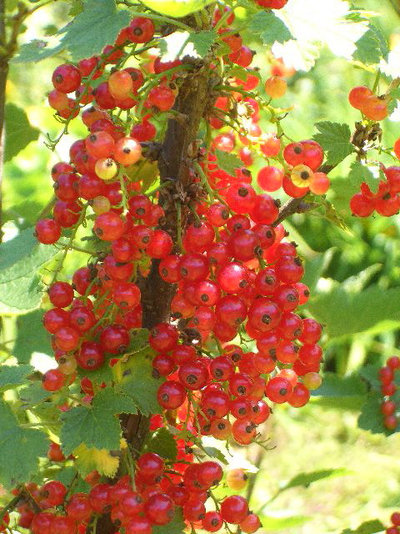
HAZEL Landscapes & Edibles
Currants and gooseberries are closely related and have a similar overall appearance, growing as shrubs about 4 to 5 feet tall (though gooseberries have thorns, and currants are thornless). Cold hardiness varies among the different varieties, but it’s possible to find currant and gooseberry cultivars that are adapted to any zone between 3 and 9.
Gooseberries and currants are not widely grown in North American gardens, though they are a standard feature in Europe, where they are often grown in the shade of mature fruit trees. These are red currants pictured here, though there are also black and white currants. Gooseberries are usually either green or red and are sweeter than currants.
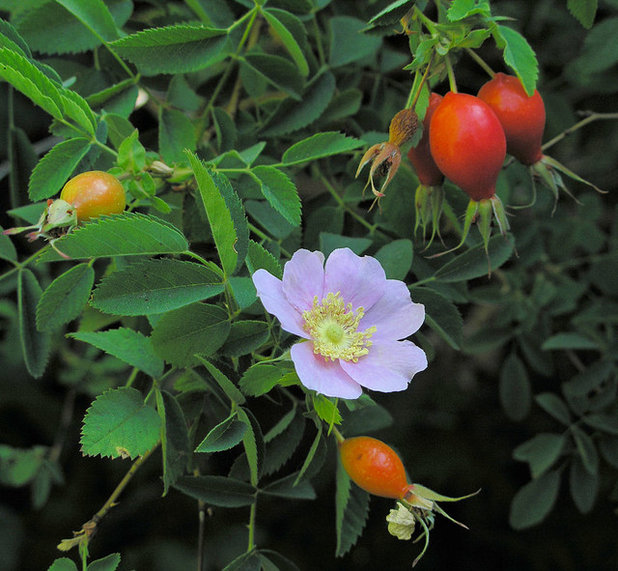
Numerous other less common fruits are capable of growing in shade. All rose hips (the berry-like fruit of a rose) are edible, and many species are adapted to the shade. However, if you really want to eat rose hips, it’s best to plant
Rosa rugosa, the main species that is commercially harvested for its hips.
Rosa rugosa is one of the toughest of all roses, spreading into a tall, dense ground cover that produces large, fleshy hips, even in moderately shaded locations. Like many shade-tolerant edibles,
Rosa rugosa is very cold hardy, growing in zones 3 to 9.
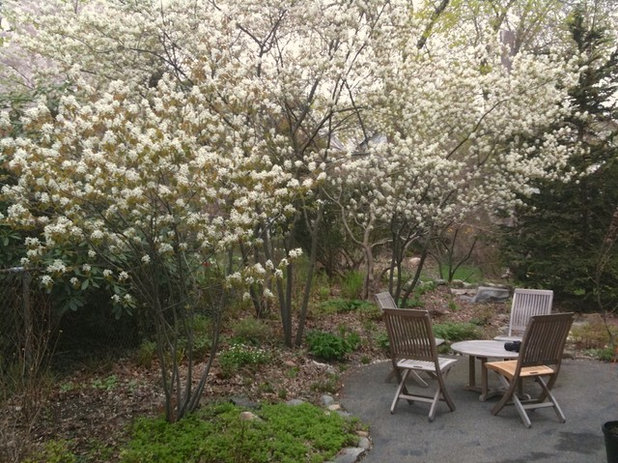
Ellen Sousa/Turkey Hill Brook Farm
There are a few small trees that have edible berries and grow well in a forest garden. Serviceberry (
Amelanchier spp
, zones 2 to 9) is one of the easiest to grow and is commonly planted as an ornamental because of its profuse white blossoms in springtime. In summer, small fruits with a blueberry-like flavor are produced in abundant quantities. Serviceberries are widely adapted, growing throughout the U.S.
See how to grow serviceberry
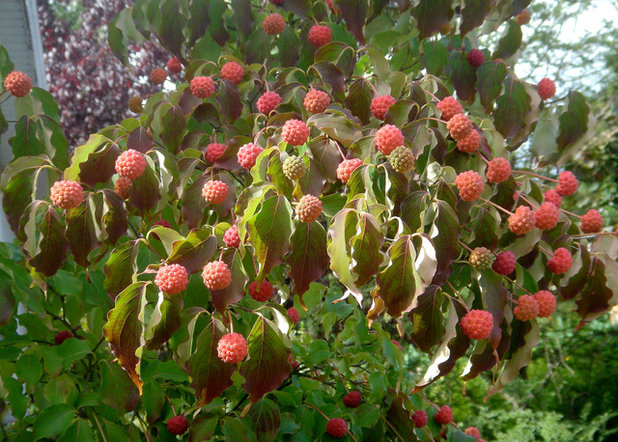
Boxleaf Design, Inc.
Kousa dogwood (
Cornus kousa,
zones 5 to 8) is another understory tree with edible fruit. This species has the same stunning spring blossoms as other dogwoods, but the 1-inch-diameter fruit that follows is edible.
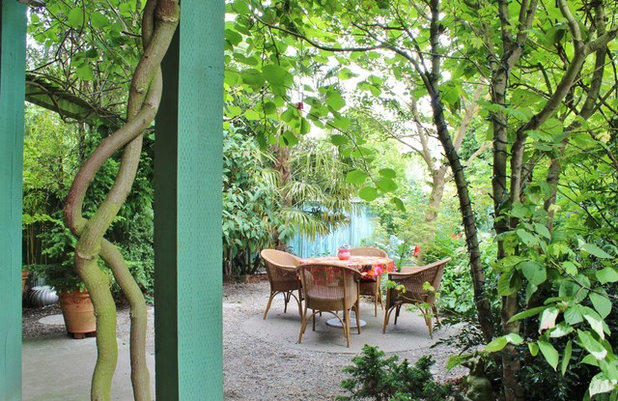
Kimberley Bryan
There are even a few rare and exotic fruiting vines that prefer to grow in the shade. Arctic beauty kiwi (
Actinidia kolomikta,
zones 3 to 9) is arguably the most beautiful. In addition to producing small, kiwi-flavored fruit, the vine is known for its triple variegated foliage (seen here on the bottom left). Male and female plants are needed to produce fruit, though only the male vines are variegated.
Akebia vines (
Akebia quinata, zones 5 to 9) are more commonly thought of as shade-tolerant ornamentals, but they occasionally produce a large, sausage-shaped fruit that has a delicious fig-like flavor.
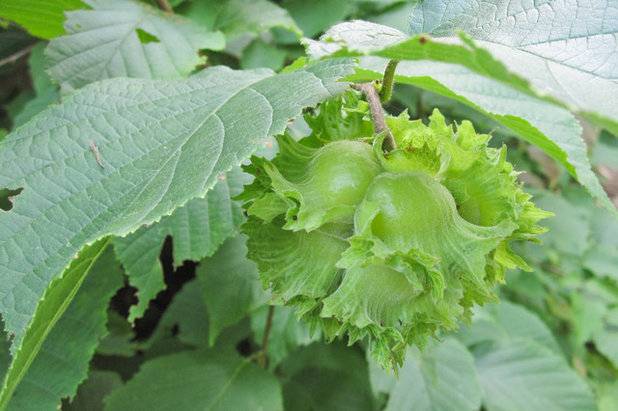
Holm Design & Consulting LLC
The list of shade-tolerant fruits goes on and on. Huckleberries (
Vaccinium spp), which are nearly identical in flavor to blueberries, and alpine strawberries (
Fragaria vesca,
zones 5 to 10) are two others to consider.
When it comes to nuts, however, there is really just one option for the shade: filberts, also known as hazelnuts. The filbert (
Corylus spp, zones 5 to 9) is an understory tree native to the forests of the Northern Hemisphere. Filberts need some sun to produce a good crop, but definitely not full sun. They are attractive, vase-shaped trees that grow up to 20 or 30 feet in height. Two varieties are needed for pollination.
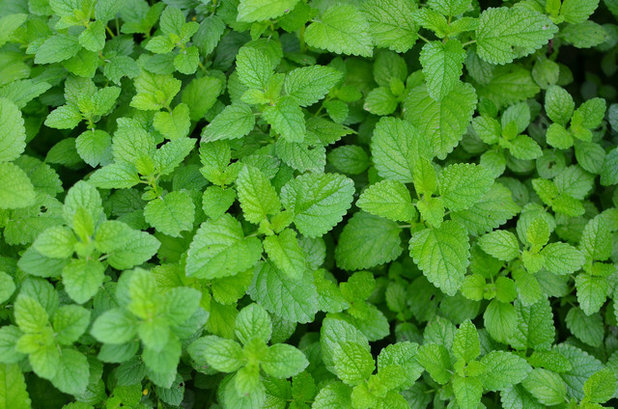
Amy Renea
Plant Shade-Adapted HerbsMints (
Mentha spp) are probably the best known example of shade-adapted herbs and are quite diverse — spearmint, peppermint, apple mint, pineapple mint, chocolate mint etc. There are other members of the mint family with excellent culinary qualities that grow in the shade as well, such as lemon balm (
Melissa officianalis). Most mints are excellent for tea, as is another shade-tolerant and often overlooked edible: the tea plant (
Camellia sinensis), which is the source of all green and black teas.
Tip: Consider growing mint in a container. It spreads quite vigorously and can take over a garden.
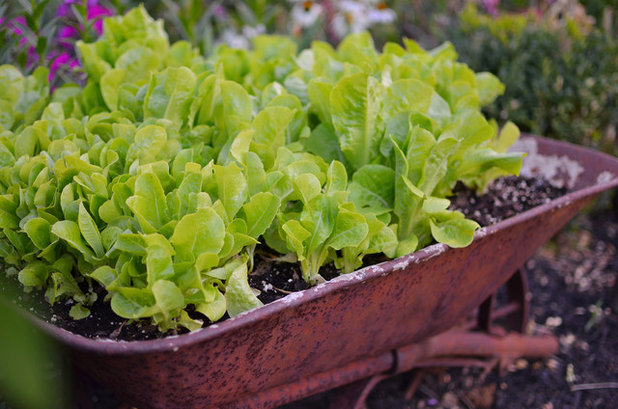
Amy Renea
Plant Leafy Greens Leafy greens are by far the best vegetables for a shade garden. Tender lettuces, chard, arugula, brassicas (such as collards and kale) and Asian greens (like mizuna and other mustards) can all get by on four hours of direct sun or eight hours of indirect sun. In hot weather, greens actually prefer shade in the heat of the day — it keeps them from bolting (setting seed), which makes the leaves bitter.
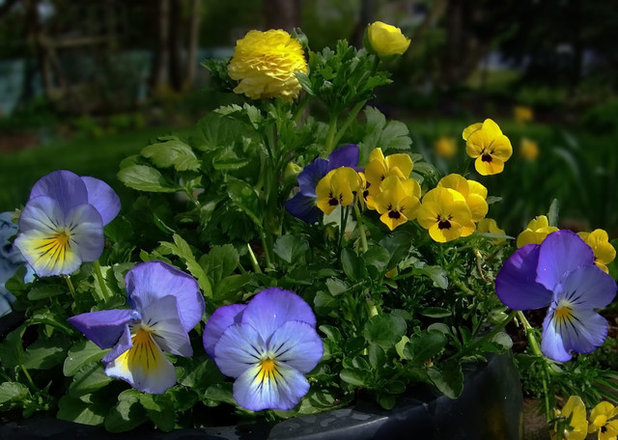
Barbara Pintozzi
Don’t Forget About Shade-Tolerant Edible FlowersPansies and violets (
Viola spp) are the most famous of these, but there are many others, including nasturtium (
Tropaeolum spp), bergamot (
Monarda spp) and fuchsia (
Fuchsia spp).
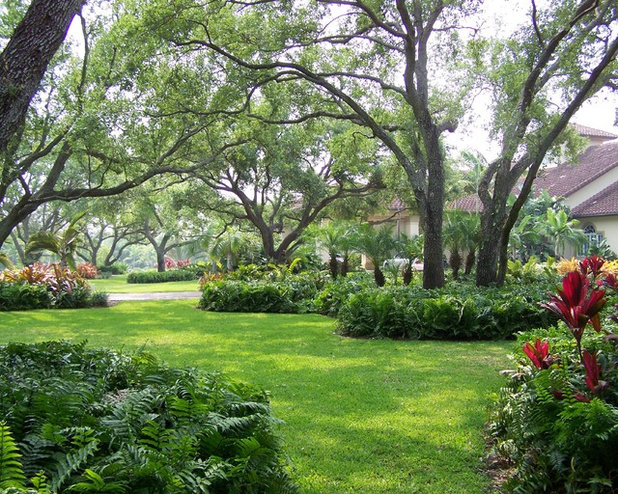
orlando comas, landscape architect.
Tip: Consider trimming your trees to let in more light. Removing the lower limbs will let in significantly more light at ground level, and professional arborists can advise you on whether or not it’s feasible to thin out the canopy to let in even more dappled sun.
More:See how one gardener built a thriving edible garden in the shade
Browse more guides to gardening with edibles





